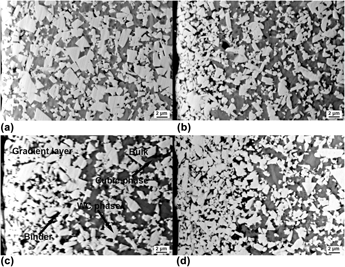Article contents
Microstructure, composition distribution and rupture performance of WC-(Ti,W)C-Ti(C,N)-Co gradient cemented carbonitrides with varied nitrogen
Published online by Cambridge University Press: 01 December 2016
Abstract

The gradient cemented carbonitrides with brittle cubic phases containing Ti removed in the surface layers were prepared in this paper. The microstructure, composition distribution, fracture morphology, and transverse rupture strength of these materials were investigated systematically. It is found that the difference between the maximum and the nominal cobalt content augments in the gradient layer, the lattice parameter of (Ti,W)C rises in the bulk inside the gradient border, and the (Ti,W)C cubic phases are refined in the inner bulk as the nitrogen is increased. Besides, the area fraction of WC in the gradient layer is higher than in the bulk, but it decreases remarkably close to the gradient border. The improvement of transverse rupture strength stability depends on thickening of gradient layers, and additionally the transgranular fracture of (Ti, W)C cubic phase can be hardly found in the gradient layer.
Keywords
- Type
- Articles
- Information
- Copyright
- Copyright © Materials Research Society 2016
References
REFERENCES
- 4
- Cited by



